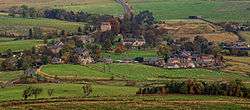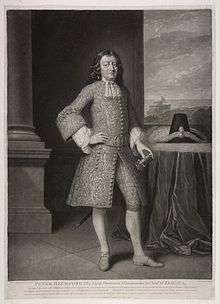Thomas Handasyd
Major-General Thomas Handasyd or Handasyde was an English soldier who served in the armies of William III and Queen Anne from 1674 to 1710. He was military commander and Governor of Jamaica from 1702 to 1710.
Major General Thomas Handasyd | |
|---|---|
 Thomas' birthplace, Elsdon, Northumberland | |
| Born | ca 1645 Elsdon, Northumberland |
| Died | 26 March 1729 Gaynes Hall, near Great Staughton, Cambridgeshire |
| Buried | St Andrews' Church, Great Staughton [1] |
| Allegiance | |
| Service/ | Army |
| Years of service | 1674-1711 |
| Rank | Major General 1710 |
| Unit | Colonel, 22nd Foot 1702-1711 [lower-alpha 1] |
| Commands held | Military commander St. John's, Newfoundland 1697-1698 Governor of Jamaica 1702-1711 |
| Battles/wars | 1672-1678 Franco-Dutch War 1689-1691 Williamite War in Ireland The Boyne 1689-1697 Nine Years War 1701-1713 War of the Spanish Succession |
| Relations | Roger Handasyd 1689-1763 (son) |
He returned to England in 1711 and later purchased Gaynes Hall near Great Staughton in Cambridgeshire, where he died on 26 March 1729.
Life

Thomas Handasyd was born about 1645 in Elsdon, Northumberland, to Colonel Roger Handasyd and his wife Margaret. He was the third of four children, three of whom lived to a great age; Gerrard (ca 1640-1735), Ann (ca 1644-?) and Roger (1653-1734).[2]
In 1686, he married Anna Morel (died 1704) and they had five surviving children; Roger Handasyd (1689-1763), Thomas (1692-1729), William (1693-1745), who all served in the military, as well as Clifford (1695-1772) and Anne (1697-1777).[3]
After he returned from Jamaica, he purchased Gaynes Hall near Great Staughton, where he died on 26 March 1729 and buried in the parish church of St Andrews.
Career
The 1638-1651 Wars of the Three Kingdoms created strong resistance in Scotland and England to a permanent military; this meant those who wanted to pursue a military career often did so in foreign armies.[4] When the Third Anglo-Dutch War began in 1672, the Duke of Buckingham was authorised to recruit a regiment for service against the Dutch.[5] Thomas' cousin James was a lieutenant in this unit and it is probable Thomas served with him.[6]
.jpg)
When England and the Netherlands made peace in the January 1674 Treaty of Westminster, these recruits enrolled in the Anglo-Scots Brigade, a mercenary unit in Dutch service. The first confirmed record of Thomas' service is his commission as captain in 1688 but he is referred to in 1698 as having '24 years service;' this makes it likely he saw action during the 1672-1678 Franco-Dutch War.[7] His movements can be traced by the birth of his first two children in the Dutch port of Heusden between 1687 to 1689, while the others were born in Ireland between 1692 to 1694.[8]
The Brigade accompanied William III to England in the November 1688 Glorious Revolution; Thomas served in the 1689-1691 Williamite War in Ireland, including the Battle of the Boyne. After the 1691 Treaty of Limerick, he was among those transferred to Flanders during the Nine Years War. In March 1694, he was appointed Major in a new regiment raised by Colonel John Gibson, a former colleague in the Dutch Brigade.[9]
%2C_plate_V_-_BL.jpg)
In June 1696, a French naval force captured the British town of St. John's, Newfoundland; this was strategically important due to its proximity to the cod fishing areas of the Grand Banks.[10] Gibson was given command of an expedition to retake it, which included Thomas; when they arrived in early 1697, the French had already evacuated the town but destroyed it first. Due to shortage of provisions, the majority of the force went back to Europe, leaving 300 men under Handasyd and the engineer Michael Richards to rebuild the town. By the time Handasyd returned to England in 1698, 214 of his men had died of malnutrition or disease, testimony to the harsh conditions.[11]

After the September 1697 Treaty of Ryswick ended the war, Parliament was determined to reduce costs; Gibson's Regiment was disbanded and by 1699, the English military was less than 7,000 men.[12] When the War of the Spanish Succession began in 1701, Thomas became Lieutenant-Colonel in the 22nd Foot, which was posted to Jamaica, a notoriously unhealthy location. Its Colonel William Selwyn died soon after arriving in April 1702 and Thomas took over as Colonel.[13]
As the senior military officer, Thomas also became Governor, an important position due to Jamaica's hugely profitable sugar plantations. It was also used as a resupply point for the Royal Navy; in March 1703, an English squadron under John Graydon was sent to attack the French town of Placentia, in Newfoundland. His ships arrived in Jamaica short of men and in poor condition; Handasyd made strenuous efforts to resupply him but the local merchants later complained about the impressment of local seamen.[14]
His wife Anna died in September 1704 and was buried in St. Jago de la Vega or Spanish Town Cathedral.[15] Like his predecessor, Sir William Beeston, Thomas had a difficult relationship with the planter-dominated Jamaican Assembly.[16] This came to a head in 1710, when he tried to dissolve the Assembly and in the ensuing commotion, its President Peter Beckford died after allegedly falling down the stairs.[17]
Thomas now requested he be relieved and was replaced as Governor by Lord Archibald Hamilton, while his son Roger became Colonel of the regiment. He was promoted Major-General and returned to England in early 1711; he purchased the estate of Gaynes Hall near Great Staughton, Cambridgeshire, where he died on 26 March 1729 and was buried in the parish church of St Andrews, where his memorial still exists.[18]
Notes
- Until 1751, most regiments were named after their Colonel but to avoid confusion, their post 1751 numbers are used
References
- "Church of St Andrew". British Listed Buildings. Retrieved 18 May 2019.
- "Major-Gen. Thomas Handasyd". Geneagraphie.com. Retrieved 18 May 2019.
- "Major-Gen. Thomas Handasyd". Geneagraphie.com. Retrieved 18 May 2019.
- Chandler David, Beckett Ian (1996). The Oxford History Of The British Army (2002 ed.). Oxford University Press. p. 52. ISBN 978-0192803115.
- Boxer, CR (1969). "Some Second Thoughts on the Third Anglo-Dutch War, 1672–1674". Transactions of the Royal Historical Society. 19: 88–90. doi:10.2307/3678740. JSTOR 3678740.
- Handyside, Rob. "Robert Handyside and the Holystone Handasyd Chalice" (PDF). Coquetdale. Retrieved 20 May 2019.
- Godfrey, Michael (1969). Handasyd, Thomas in The Dictionary of Canadian Biography Volume 2 (Online ed.). Univ of Toronto Pr / Les Presses de L'Universite Laval.
- "Major-Gen. Thomas Handasyd". Geneagraphie.com. Retrieved 18 May 2019.
- Godfrey, Handasyd, Thomas
- Marley, David F (2008). Wars of the Americas: A Chronology of Armed Conflict in the Western Hemisphere; Volume I (2008 ed.). ABC-CLIO. p. 328.
- Godfrey, Handasyd, Thomas
- Gregg, Edward (1980). Queen Anne (Revised) (The English Monarchs Series) (2001 ed.). Yale University Press. p. 126. ISBN 0300090242.
- Cannon, Richard (1849). Historical Record of the Twenty-Second, or the Cheshire Regiment of Foot (2015 ed.). Andesite Press. p. 5. ISBN 1296561828.
- Laughton, JK, Davies, JD (2004). Graydon, John (died 1726) (Online; 2008 ed.). Oxford DNB. doi:10.1093/ref:odnb/11359.
- Poinsett, William, Robertson, James. "The Spanish Town Cathedral". www.markdgljmci.com. Retrieved 21 May 2019.
- Austin, PB, Zahedieh, Nuala (2004). Beeston, Sir William (1636-1702) (2008; Online ed.). Oxford DNB. doi:10.1093/ref:odnb/1955.
- Black, Carlysle (1975). History of Jamaica (1988 ed.). Hodder. p. 79. ISBN 978-0582038981.
- Peel, Robin. "Great Staughton church; St Andrews". Churchcrawling.com. Retrieved 21 May 2019.
Sources
- Austin, PB, Zahedieh, Nuala (2004). Beeston, Sir William (1636-1702) (2008; Online ed.). Oxford DNB.
- Black, Carlysle (1975). History of Jamaica (1988 ed.). Hodder. ISBN 978-0582038981.
- Chandler David, Beckett Ian (1996). The Oxford History Of The British Army. Oxford University Press. ISBN 978-0192803115.
- Godfrey, Michael (1969). Handasyd, Thomas in The Dictionary of Canadian Biography Volume (Online ed.). Univ of Toronto Pr / Les Presses de L'Universite Laval.
- Gregg, Edward (1980). Queen Anne (Revised) (The English Monarchs Series). Yale University Press. ISBN 0300090242.
- Hamilton, Douglas J. Jacobitism, Enlightenment and Empire, 1680–1820. Routledge, 2015
- Laughton, JK, Davies, JD (2004). Graydon, John (died 1726) (Online; 2008 ed.). Oxford DNB.
- Marley, David F (2008). Wars of the Americas: A Chronology of Armed Conflict in the Western Hemisphere; Volume I. ABC-CLIO.
External links
- "Church of St Andrew". British Listed Buildings.
- "Major-Gen. Thomas Handasyd". Geneagraphie.com.
- Poinsett, William, Robertson, James. "The Spanish Town Cathedral". www.markdgljmci.com.
- Peel, Robin. "Great Staughton church; St Andrews". Churchcrawling.com.
| Government offices | ||
|---|---|---|
| Preceded by Peter Beckford (acting) |
Governor of Jamaica 1702–1711 |
Succeeded by Lord Archibald Hamilton |
| Military offices | ||
| Preceded by William Selwyn |
Colonel, 22nd Foot 1702–1712 |
Succeeded by Roger Handasyde |